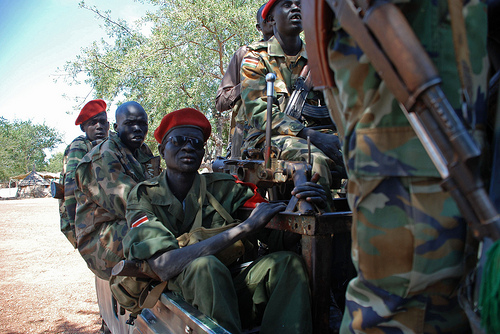
Cyclical inter-communal violence has common in South Sudan for decades and the most recent flare-up of heavy fighting in Jonglei state has been going on for months. The continued tension, attacks, and fear of reprisals have displaced an estimated 140,000 people as of early February 2012. The pervasive problem of insecurity, retaliatory violence, and lack of state capacity in service delivery and civilian protection presents a huge challenge to the government of South Sudan.
The layers of support and influence surrounding the Lou-Nuer White Army, a group central to fighting in Jonglei state, have been complex and rather opaque. There have been questions about diaspora support of the armed youth, speculations about the incentives of powerful local politicians in stoking violence, and support for the youth on the part of established militia groups.
A new Small Arms Survey report released last week cites evidence of external support of the White Army. After conducting research in Akobo, Likuongole, and the area surrounding Pibor town, Small Arms Survey found evidence of linking the White Army to weapons and ammunition identical to those used by both the SPLA and prominent rebel groups in South Sudan.
The report identifies several rounds of ammunition that were identical to cartridges seized from George Athor’s forces in March 2011, suggesting that Athor’s militia was a potential source of arms and ammunition for the White Army. Similarly, in Akobo, Small Arms Survey researchers witnessed Nuer youths with assault rifles and rocket-propelled grenades identical to models seized from Peter Gadet and George Athor in early 2011. There has long been significant circumstantial evidence linking Athor to the provision of weapons to Lou- and Jikany-Nuer youth in Jonglei state.
There is also evidence that supports “allegations that Nuer members of the SPLA supported the White Army’s attack on Pibor.” Several cartridges retrieved from the area surrounding Pibor town point to some level of SPLA support for the White Army. But it is impossible, even with this newfound evidence, to ascertain the scale of support from both Athor and the SPLA to the White Army.
This report was release amid heightened tensions surrounding the South Sudan government-led disarmament campaign in Jonglei state. Regardless of where these weapons are coming from the South Sudanese government must critically reevaluate its disarmament strategy. Jonglei state, as most other regions of South Sudan, is flush with weapons. Compounding this problem, the state lacks the capacity to protect civilians from inter-communal violence, making armed civilians very reluctant to give up their weapons.
Disarmament is only one element of a plan to end violence in Jonglei state. Importantly, disarmament should be sequenced appropriately within a comprehensive approach that includes political processes, peace-building, and reconciliation. Disarmament alone cannot hope to end inter-communal violence; in fact, stand-alone disarmament is likely to further inflame the situation.
Enough has highlighted the dangers of a stand-alone disarmament campaign that attempts to confiscate weaponry before communities have undergone reconciliation and peace-building processes. Moreover, the recently announced disarmament strategy is problematic because it fails to appropriately address high-level political concerns alongside grassroots efforts for reconciliation.
Photo: SPLA soldiers (Enough / Laura Heaton)

